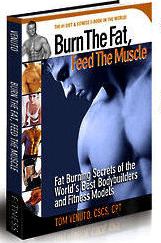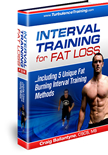Fat Loss Is as Individual as You Are
 In last day’s post, I introduced to you Tom Venuto, who is a weight loss expert and natural body builder with over 22 years of experience in the industry.
In last day’s post, I introduced to you Tom Venuto, who is a weight loss expert and natural body builder with over 22 years of experience in the industry.
He is also the author of the best-selling fat loss diet and nutrition e-book in Internet History called Burn the Fat; Feed the Muscle with almost 200,000 readers in 144 countries so far. Today the fat loss guru shares his thoughts on different fat loss approaches.
So let’s see what he has to say.
**********************
Craig Ballantyne: Most of my articles and interviews on my sites promote interval training. However, traditional “cardio” has worked for many people. In your opinion, how does traditional cardio compare to interval training? What are the pro’s and con’s of each?
Tom Venuto: Well, I would agree with what Ian King wrote recently in one of his Q & A columns, “As to whether you respond best to higher intensity interval training (HIIT) or lower intensity steady state training will depend a lot on you. You should try both (not concurrently) and compare.”
You simply have to experiment. Test and discover for yourself what works best. How do you know what works best if you don’t test it and measure the results? I don’t create my own program based on what the latest research says or what the popular trend is. I look at the research and pay attention to what’s going on at the “cutting edge,” but don’t live and breathe by it. I do what produces results, period.
There’s no doubt interval training is highly effective and supported with research. A great benefit of interval training for many people is time efficiency. Another is that it is mentally and physically engaging. Long duration conventional cardio can bore some people to tears.
My personal preference for my own fat loss cardio training is to work at the highest heart rate I can comfortably maintain for the entire duration of the workout, 20-30 minutes. During pre-contest preparation, I often increase – in a progressive fashion – to as much as 30-45 minutes, so my program to this day is primarily conventional cardio. I occasionally add in interval training more for variety than anything. I do like stair and hill sprinting though, and have done that for years. Oddly enough, I never really considered it “cardio” – I looked at it more as an adjunct to my leg workouts, although I’m sure I reaped some fat loss benefits from it.
We’ve all seen the research that compares low intensity, long duration cardio to HIIT, and we’ve seen the superiority of HIIT, but I’d like to see some research comparing, let’s say, 20 minutes of HIIT with 30-45 minutes of challenging steady cardio at the top of your target heart zone. I find this type of cardio extremely effective, and I imagine there’s a pretty substantial post workout after burn in addition to the very large burn of fat calories during the workout. It’s nice to know, though, that you CAN get a productive workout in just 20 minutes or less with HIIT.
Regardless of whether we’re talking about interval training or conventional cardio, you want to burn as many calories as you can given the time you have. I definitely don’t believe in the idea that low intensity cardio burns more total fat. That myth has clearly been debunked by the research, even though it still persists.
Naturally, beginners and de-conditioned people need to build some kind of fitness base before doing the really high intensity stuff. HIIT can be risky for certain people. Simple conventional cardio like walking is fantastic for the elderly and overweight, although cardio shouldn’t take precedence over weight training in any population.
Craig Ballantyne: Given all these pro’s and con’s, what’s the best training approach for the masses looking to lose fat and maintain (or even gain) muscle?
Tom Venuto: It Depends entirely on the person. Nutrition and training have to be customized. There’s no such thing as a single best approach. We see people make great gains on abbreviated high intensity training and also on high volume. We see people lose fat on conventional cardio and HIIT cardio…with high carbs/low fat and low carbs/high fat. However, one thing is always true – there are fundamentals, which apply to everyone. Each person has to master the fundamentals first. Once you have that down, you begin to personalize.
That’s where a really good fitness professional comes in – to evaluate an individual’s situation and make the optimal exercise prescription within that particular context. There is no single best training approach because everyone is so different.
The nutrition fundamentals are important of course, but strength training is really the key fundamental for everyone. It’s a shame that strength training is still underplayed in the weight loss mainstream. Dieting is still king, but ironically, low calorie dieting is part of the problem it purports to cure. Weight training is critical to fat loss and I have no argument against weight training and full body workouts being used effectively as the sole means for fat loss. Results are what counts and time efficiency is more important to some than others. I simply think that some people have taken their anti-aerobics sentiment a bit too far.
Just a couple decades ago the entire health and fitness movement revolved around aerobics, while strength training was ignored and ridiculed. Today, in certain strength circles, the pendulum has swung completely to the other side: aerobics is ridiculed and strength training is said to be the best way to burn fat. I actually find it kind of funny when trainers are so against cardio that when they do recommend it, they won’t even call it “aerobics” or “cardio”, they call it something else: “Energy system training.”
Strength training has a critical role in fat loss, but is it really more important than cardio? The negative effects of excessive cardio on strength have been clearly proven, but how much is “excessive?” Can’t the two work synergistically together if work and recovery are carefully balanced? For people who are not strength/power athletes, is a little bit of extra cardio really such a big concern? Shouldn’t training always be organized around priorities with the main priority never compromised?
Using strength training to burn fat is not a new concept. We had PHA training (peripheral heart action) and circuit training many years ago. Bodybuilders have been reducing rest intervals (increasing density), and using supersets, tri sets or giant sets during pre-contest phases since bodybuilding began. Maybe they didn’t understand growth hormone and the other mechanisms that made them work, they just did it instinctively, but they also did cardio.
And the problem is, the more you turn strength training into cardio (“circuit training”), the more you compromise your strength and muscle mass increases. I like the balance between conventional (and heavier) strength training, moderate cardio and nutrition the best, although I certainly use increasing density and supersetting during fat loss programs.
I’ll go against the current trend in the strength community and stand by my belief that except for big “manly” strength athletes who can stick with weight training alone, the preferred fat loss approach, most of the time, for most people, is a healthy balance between strength training and cardio training.
In part 3 Tom will share his thoughts on the frustrations that people may have who do everything right and not getting the results.